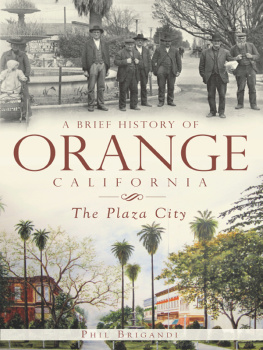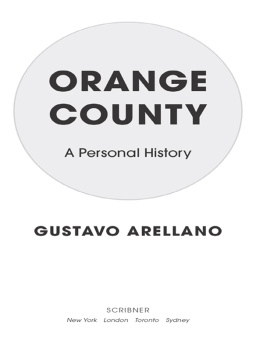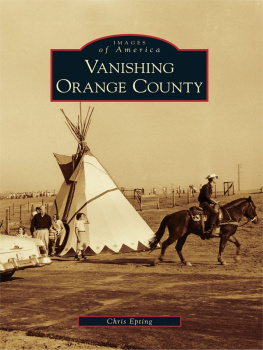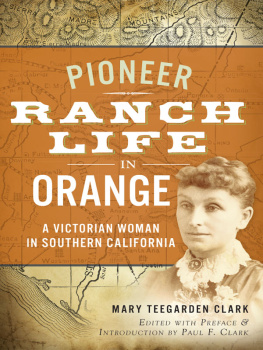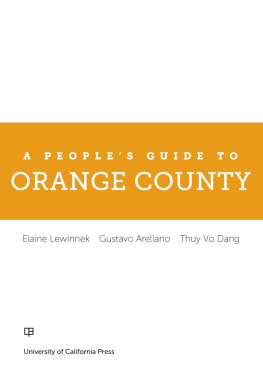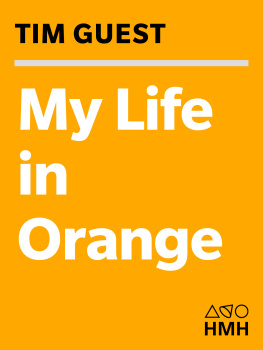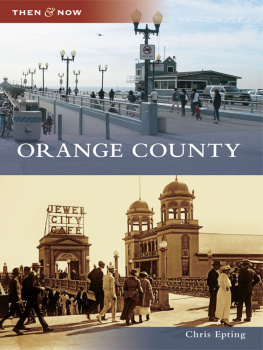

Published by The History Press
Charleston, SC 29403
www.historypress.net
Copyright 2011 by Phil Brigandi
All rights reserved
Front cover, bottom: Downtown Orange in the 1920s, by local artist Harry Keltner, 1985.
Courtesy the artist.
First published 2011
e-book edition 2012
ISBN 978.1.61423.394.7
Library of Congress Cataloging-in-Publication Data
Brigandi, Phil, 1959
A brief history of Orange, California : the plaza city / Phil Brigandi.
p. cm.
Includes bibliographical references and index.
print edition ISBN 978-1-60949-287-8
1. Orange (Calif.)--History. I. Title.
F869.O6B74 2011
979.496--dc23
2011028515
Notice: The information in this book is true and complete to the best of our knowledge. It is offered without guarantee on the part of the author or The History Press. The author and The History Press disclaim all liability in connection with the use of this book.
All rights reserved. No part of this book may be reproduced or transmitted in any form whatsoever without prior written permission from the publisher except in the case of brief quotations embodied in critical articles and reviews.
CONTENTS
INTRODUCTION
The story of Orange is the story of a little town that got bigand yet still retains some of that small-town feel. Founded in 1871 and incorporated in 1888, a year before the southern end of Los Angeles County broke away to form Orange County, the city of Orange was primarily an agricultural community until the 1950s, when modern suburban development arrived.
Today, our population tops 135,000, yet many people still think of Orange as a small town. Part of that image comes from our historic downtownnot just the business buildings around the Plaza, but the blocks and blocks of historic homes surrounding it, many of them lovingly restored. The Plaza is the heart of old Orange and a symbol of our small-town origins. While other Orange County cities have swept their downtowns clean or redeveloped them into bland, beige blocks of stucco, downtown Orange still retains much of its original look and feel.
And its the Plaza, not the Circle (as the bumper stickers around town say). The tongue-in-cheek battle between the locals and newcomers is simply a way for the hometown folks to say, This is my town, and I care about its past. Try saying Frisco to a true San Franciscan and youll get the idea.
I was born in Orange and went all through school here. Ive been researching and writing its history since 1975. Over the years, Ive spent countless hours reading through old newspapers and talking with old-timers. It is that combination of documentary sources and living memory that always makes for the best local history.
So many old-timers have been helpful to me over the years it is difficult to pick out just a few, but I will always fondly remember the help and support I received from Florence Smiley, Lena Mae Thompson, Kellar Watson, Ken Claypool, Harold Brewer, David Hart and so many others.
I am also very appreciative of the other historians who have written about the history of Orange over the years, including Wayne Gibson, Paul Clark, Jim Sleeper and most of all Don Meadows, my great mentor as a local historian.
At its best, local history shows us how we got to where we are and offers some clues of where we are going. The issues and challenges we faced in the past will often meet us again. Knowing that others found solutions in the past should give all of us hope for the future.
Chapter 1
BEFORE WE WERE ORANGE
My father claimed to be an owner of the Santiago de Santa Ana ranch. He died in the year 1829. He was a partner of the rich Yorba [Jos Antonio Yorba I]. I knew [his sons] Jos, Tomas and Teodosio Yorba. They lived near where Orange now is. Tomas used to have a vineyard and used to occupy himself in taking care of it and his crops, and his vaqueros used to look after his stock. He cultivated and irrigated corn, beans and wheat. He had a great many servants and cultivated a good deal. Jos Yorba [II] cultivated land in 1835 to a considerable extent. The land so cultivated was west of Orange. He raised there corn, wheat, watermelons, pumpkins and a small variety of beans. He had a great number of servants employed aiding in the cultivation. Teodosio Yorba also cultivated land in 1835 which was situated between the other two Yorbas. Tomas Yorba was next to him above, and Jos was located further down.
Rafael Peralta (18161894), son of Juan Pablo Peralta, testifying in the water lawsuit between Orange and Anaheim, 1880
Long before California became part of the United States, the level plain south and east of the Santa Ana River was known as the Rancho Santiago de Santa Ana. Both names date back to the Portol Expedition of 1769, the first Spanish soldiers to march overland through California.
Captain Juan Gaspar de Portol and his men were heading north from San Diego, where Californias first mission had just been founded, in search of Monterey Bay. As they crossed what is now Orange County, they gave us a number of place names that survive to this day. The Santa Ana Mountains were named on St. Annes Day on the Catholic calendar. Soon the name spread to take in the river that flows out of the mountains. At Trabuco Creek, one of the soldiers lost his blunderbuss gunin Spanish, his trabuco.
On the evening of July 27, 1769, the expedition stopped beside another creek. It was St. James Day, so the creek became known as Santiago. Portol and his men camped about half a mile above where Chapman Avenue now crosses the creek. The expeditions priest, Father Juan Cresp, noted in his diary:
We halted after three leagues of travel near an arroyo of running water. It has willows, grapevines, brambles, and other bushes. The water comes down from the mountains and shows the arroyo must have plenty of water in the rainy seasonIf this watering place should remain throughout the year, it would be a site for building a city on account of the large amount of land and the extensive plain that the arroyo has on both sides.
In 1771, the Spanish founded a mission at San Gabriel. Five years later, the Mission San Juan Capistrano was founded by Father Junpero Serra. The missions were the first step in the Spanish colonization of the area, designed to convert the local Indians to Catholicism and teach them useful trades so they could become citizens of the Spanish Empire. Mission San Gabriel grazed cattle and horses all the way down to the Santa Ana River, while San Juan Capistranos flocks grazed to the south.
Colonists were also sent north from Mexico to help found Californias first pueblos. In the winter of 177576, Colonel Juan Bautista de Anza led the first large group of settlers across the desert to San Gabriel. One of Anzas chief lieutenants was Juan Pablo Grijalva, an experienced frontier soldier.
As the years went by, Californias earliest Spanish soldiers began to retire, and a number of them decided to remain here. Cattle ranching was Californias prime industry in the early days, with the hides and tallow sold to trading ships that carried them away to England and the eastern United States, so the soldiers sought land to raise their own herds.
About 1800, Juan Pablo Grijalva began running cattle along the Santiago Creek. In 1801, the commander at the presidio in San Diego gave preliminary approval for him to occupy the place of the Arroyo de Santiago. Before long, Grijalva had built an adobe ranch house atop a small hill overlooking the creek. Today, the Hoyt house (built in 1888) covers the site, above the southeast corner of Hewes Avenue and Santiago Canyon Road.
Next page
